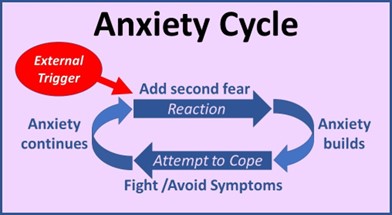Anxiety occurs in a very predictable cycle. Understanding the anxiety mechanism is the foundation for recovery. Here is how the anxiety cycle works, step by step:
- Our anxiety is triggered by a thought, a situation, or an event
- We feel anxious
- Our subconscious mind activates our body’s fight or flight response
- We get physical and emotional sensations from the adrenaline released
- Our subconscious mind associates these sensations with fear and danger, and concludes (incorrectly of course) that we must be in actual danger
- Our subconscious mind reacts to this apparent danger by sending anxious and fearful thoughts up to our conscious mind
- Our conscious mind reacts with fear (adds second fear)
- Our anxiety increases, and we go back to step 2 but with a higher level of anxiety than before
We can repeat steps 2 to 8 many times. We get elevated anxiety levels when this happens slowly. If it happens quickly it can result in a panic attack.

Vigilance and Anticipation
What we tend to do when caught up in the anxiety cycle is try to intercept the initial triggers. We usually have a number of things that trigger us – a particular type of situation or activity, a place, a person, or a particular type of look or comment, or a particular subject that comes up.
We are constantly on the lookout and anticipate upcoming situations that might trigger anxiety, in the hopes that we might be able to avoid the trigger altogether, or intercept it before it activates our anxiety, or suppress our reaction when the trigger happens.
This vigilance and anticipation itself of course makes us anxious, which is exactly the thing we were trying to avoid in the first place. And on top of that, it does not work. The triggers slip past all our defenses and set our anxiety off. And round the anxiety cycle we go – again!
We try to intercept the triggers because everything else seems to happen automatically and inevitably. It never works for us but we keep trying, hoping that maybe there is something we will stumble upon, some technique, affirmation or way of thinking that might prevent the anxiety from being triggered.
However, all we succeed in doing is keeping ourselves anxious pretty much all the time in anticipation of the next anxiety or panic attack. We are stuck in the anxiety state.
Are we stuck here forever? What did we miss? Is there a way out? What is it?
The Key to Recovery
A closer look at the anxiety cycle laid out above shows that while most of it is automatic, and occurs deep in our subconscious where we cannot directly impact it, step 7 – adding second fear – occurs in our conscious mind. This is our reaction to the anxiety symptoms and sensations. We fear and hate our anxiety, and fight it.
This is what can be changed. We can learn how to stop adding second fear, i.e. stop reacting to our anxiety with fear and hatred. We can discover how to face and allow it, willingly and without judgment, and surrender to it. It is safe to surrender. We are not in actual danger.
Those are the two skills needed to recover from anxiety:
- Stop adding second fear
- Surrender completely to the symptoms, sensations, and feelings of anxiety
If you do this repeatedly, you gradually lose your fear of the anxiety. And once you do that, you automatically lose your fear of the triggers too, because why would you fear those anymore now that you don’t fear feeling anxious?
Trying to avoid or suppress anxiety is always going to be a losing proposition. It will never succeed, simply because of the way the anxiety cycle works. The only way to recover is to lose our fear of anxiety. We do this by allowing it without resistance, and not reacting to it with fear, judgment, hatred or fighting.
Check out this link for more information on Expectations and Judgments







